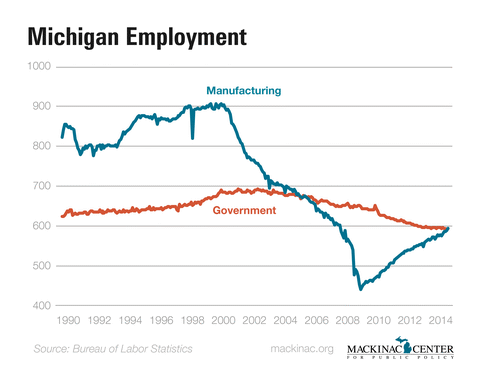Manufacturing Jobs Set to Surpass Government Jobs in Michigan for First Time in Years
That hasn't happened since November of 2005
For the first time in 110 months, the number of manufacturing jobs could exceed the number of government jobs in this state, according to data from the federal Bureau of Labor Statistics.
As of February 2015, the latest period for which data is available, there were 593,300 government jobs in Michigan and 593,100 manufacturing jobs.
Employment in Michigan took a beating during the 2000s, said Michael LaFaive, director of the Morey Fiscal Policy Initiative for the Mackinac Center for Public Policy, in an email.
“Manufacturing was just one industry that was hit hard,” LaFaive said. “Finally after eight long years, manufacturing employment is poised to once again exceed government employment in Michigan.”
In the 1990s, Michigan manufacturing jobs consistently outnumbered government jobs. That ended in September 2005, when BLS statistics showed 675,000 government jobs and 674,000 manufacturing jobs in the state. The figures shifted slightly during the next two months before tilting over on a long-term basis in December 2005. Starting that month, government jobs exceeded manufacturing jobs, and kept that edge for the next 111 months.
The most recent figures are from February of this year, when Michigan manufacturing jobs were just 200 fewer than the number of government jobs. The largest employment gap between the two sectors came in June 2009, when there were nearly 227,000 more government jobs than manufacturing jobs.
Mark Perry, a scholar at the American Enterprise Institute and a finance and business professor at the University of Michigan-Flint, said there were several reasons for a rise in manufacturing in Michigan.
Perry said the auto industry recovered from the 2009 Great Recession due in part to a general economic recovery. The industry was further boosted by the lowest auto loan interest rates in at least 50 years, leading to strong auto sales.
Michigan government employees include those who work for the local, state and federal government as well as universities and colleges and K-12 school districts. Manufacturing includes all the factories in Michigan.
“As the auto industry has recovered, so had the demand for autoworkers, which has helped boost Michigan manufacturing payrolls to the highest level in nearly seven years, going back to early 2008,” Perry said in an email.
He said not many recognize that the Great Recession caused the public sector to contract and downsize.
“For example, compared to pre-recession peaks in 2007, there are 131,000 fewer state government jobs nationally, 195,000 fewer federal employees, and 524,000 fewer local government employees. Together, that means there are about 850,000 fewer government employees today than in 2007,” Perry said.
LaFaive said during the early 2000s, Michigan’s economy slumped while the national economy improved.
“That is what made the period unique,” he said. “Typically Michigan does well when the nation does well. I would suggest that the decline in the state’s economic fortunes was unusually deep in part due to many of the policies the Legislature and governors of that decade adopted, including large tax and fee hikes, regulation hostile to commerce and reliance on corporate welfare subsidies. In addition, an air of uncertainty was created for business leaders as lawmakers scrapped a hated and onerous Single Business Tax for the hated and perhaps more onerous Michigan Business Tax.”
There has been dramatic improvement in Michigan’s public policy landscape, LaFaive said, pointing to the right-to-work law and business tax cuts.
Michigan Capitol Confidential is the news source produced by the Mackinac Center for Public Policy. Michigan Capitol Confidential reports with a free-market news perspective.


